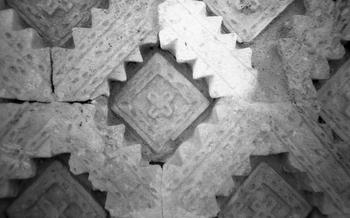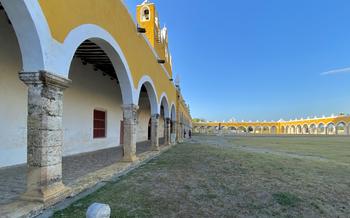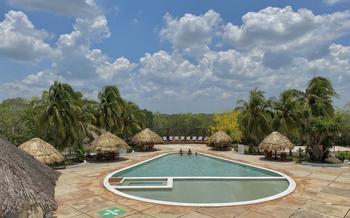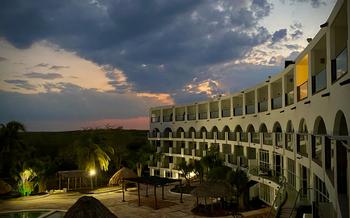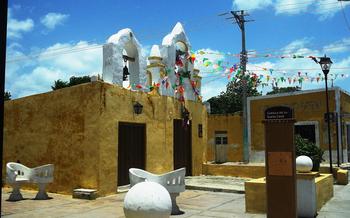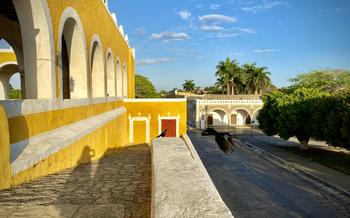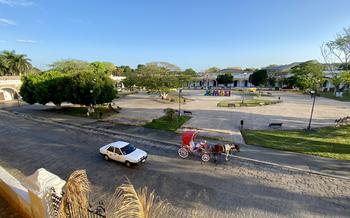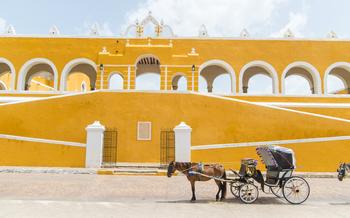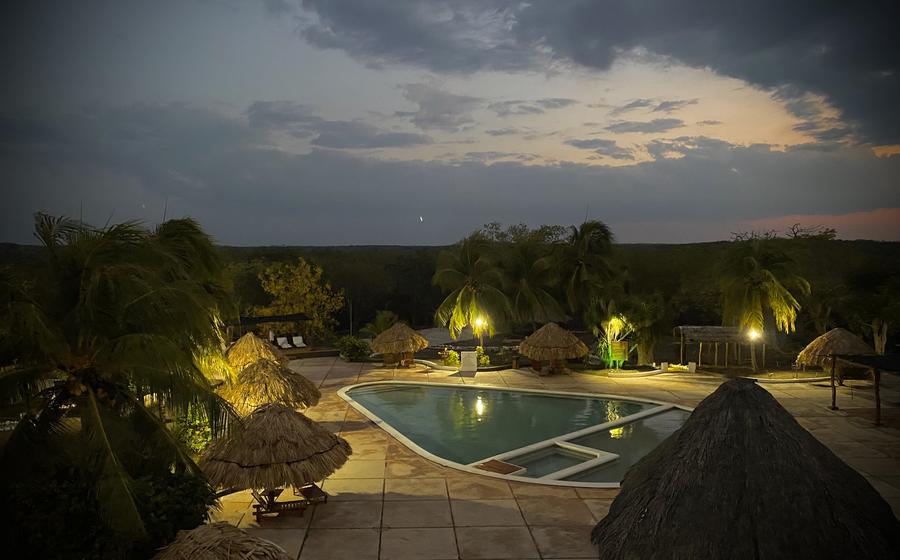
Teabo Church and Convent
- Uxmal's Historical Significance
- Exploring the Teabo Church and Convent
- Admiring the Church's Exterior
- Stepping Inside the Teabo Church
- Learning about the Convent's History
- Exploring the Convent's Architecture
- Unveiling the Convent's Artwork
- Attending a Mass or Religious Service
- Visiting the Town of Teabo
- Planning Your Visit
- Capturing the Beauty:
- Respecting Local Customs
- Supporting Local Initiatives
- Exploring Beyond the Church and Convent
- Insider Tip: Uncovering the Hidden Cenote
Uxmal's Historical Significance
Uxmal, an ancient Maya city located in the Yucatán Peninsula of Mexico, holds a significant place in the region's history. As one of the largest Maya cities during the Classic period (250-900 AD), Uxmal played a vital role in the political, economic, and cultural development of the Maya civilization. Its well-preserved ruins, which showcase a unique architectural style, have earned Uxmal the distinction of being a UNESCO World Heritage Site. Visitors to Uxmal can marvel at the intricate carvings, towering pyramids, and impressive plazas that tell the story of a once-thriving metropolis.
Exploring the Teabo Church and Convent
The Teabo Church and Convent, also known as the Parroquia de la Asunción, stand as testaments to the region's rich history and cultural fusion. The church, constructed in the late 16th century, boasts an impressive façade adorned with intricate carvings, showcasing a blend of Maya and Spanish architectural styles. Its bell tower, a prominent landmark, offers panoramic views of the surrounding landscape, inviting visitors to soak in the breathtaking scenery. The adjoining convent, established in the 17th century by Franciscan missionaries, played a crucial role in spreading Christianity in the region. Today, it serves as a testament to the enduring legacy of the Franciscan order and the profound impact they had on the local community.
Admiring the Church's Exterior
The Teabo Church's exterior is a testament to the skill and artistry of the Maya builders. The impressive façade features intricate carvings depicting scenes from the Bible and Maya mythology. The bell tower, a prominent feature of the church, stands tall and majestic, inviting visitors to explore its rich history. The surrounding gardens, with their colorful flowers and lush greenery, add to the overall ambiance of the church, creating a serene and inviting space for contemplation and reflection.
Stepping Inside the Teabo Church
The interior of the Teabo Church is a testament to the skill and artistry of the Maya and Spanish craftsmen who built it. The church's design is simple yet elegant, with a focus on natural light and open spaces. The walls are adorned with colorful murals depicting biblical scenes, while the altar and pulpit are intricately carved with Maya motifs. The church also features a number of well-preserved religious artifacts, including a silver chalice and a wooden crucifix.
One of the most striking features of the church's interior is its high vaulted ceiling. The ceiling is supported by a series of massive stone columns, which create a sense of awe and grandeur. The columns are decorated with intricate carvings, which depict Maya gods and symbols. The ceiling itself is painted with a vibrant blue sky, which is dotted with stars and clouds.
The altar is the focal point of the church's interior. It is made of carved stone and features a large, ornate cross. The altar is flanked by two statues of saints, which are also carved from stone. The pulpit is located to the side of the altar, and it is also made of carved stone. The pulpit is decorated with a series of reliefs depicting scenes from the Bible.
The Teabo Church is a beautiful and historic building that is well worth a visit. The church's interior is a treasure trove of Maya and Spanish art and architecture, and it is a place where visitors can learn about the region's rich history and culture.
Learning about the Convent's History
During the colonial era, the Teabo Convent played a crucial role in the spread of Christianity and the establishment of Spanish rule in the region. Franciscan missionaries, driven by their religious zeal, arrived in Teabo and founded the convent as a center for evangelization. The missionaries worked tirelessly to convert the Maya people to Catholicism, using a combination of persuasion, education, and, at times, coercion. The convent served as a base for their activities, providing them with accommodation, supplies, and a platform to spread their message. Through their efforts, the Franciscan missionaries left an indelible mark on the religious landscape of Teabo and the surrounding region, shaping the local culture and beliefs that persist to this day.
Exploring the Convent's Architecture
The Teabo Convent boasts a remarkable architectural layout, showcasing a blend of Maya and Spanish influences. Visitors can explore the convent's various sections, including the cloisters, the courtyard, and the living quarters. The cloisters, with their arched walkways and intricate carvings, offer a serene and contemplative space. The courtyard, surrounded by lush vegetation and adorned with a central fountain, provides a tranquil oasis within the convent walls. The living quarters, once home to the Franciscan missionaries, have been carefully preserved and offer a glimpse into their daily lives. The unique architectural features of the convent, such as the use of Maya construction techniques and the integration of Maya motifs into the design, make it a fascinating example of cultural fusion.
Unveiling the Convent's Artwork
The Teabo Convent is adorned with a remarkable collection of artwork that blends Maya and European influences, creating a unique visual narrative. Paintings and sculptures grace the walls and altars, each piece telling a story or conveying a religious message.
The paintings, mostly created by indigenous artists, depict scenes from the Bible and the lives of saints, rendered in a style that combines Maya iconography with European techniques. The vibrant colors and intricate details bring these biblical stories to life, making them accessible and relatable to the Maya community.
Alongside the paintings, sculptures carved from wood and stone adorn the convent's interior. These sculptures often depict Maya deities and mythological figures, such as Chaac, the god of rain, and Kukulcan, the feathered serpent deity. The juxtaposition of these Maya elements with Christian iconography reflects the syncretism that took place during the colonial era, as the Maya people sought to reconcile their traditional beliefs with the new religion.
The artwork in the Teabo Convent is not only aesthetically pleasing but also holds deep cultural and historical significance. It provides a glimpse into the complex and fascinating process of cultural exchange and adaptation that occurred in Mexico during the colonial period.
Attending a Mass or Religious Service
Attending a mass or religious service in the Teabo Church offers a unique opportunity to immerse oneself in the spiritual traditions of the Maya people. The church's interior comes alive with the sounds of traditional Maya hymns and prayers, sung in the native Yucatec Maya language. Visitors can witness the blending of Maya and Catholic traditions, as the mass incorporates elements of both religions. Participating in a traditional Maya ceremony, such as a blessing or a purification ritual, provides a profound insight into the rich cultural heritage of the region. These ceremonies offer a glimpse into the spiritual beliefs and practices that have been passed down through generations.
Visiting the Town of Teabo
The town of Teabo, nestled in the heart of the Yucatán Peninsula, is inextricably linked to the Teabo Church and Convent. Steeped in history and tradition, Teabo offers visitors a glimpse into the vibrant Maya culture that has thrived in this region for centuries. As you stroll through the town's narrow streets, you will be greeted by friendly locals who are proud to share their heritage and traditions.
The town's main square, adorned with colorful murals depicting scenes from Maya mythology, is a testament to the town's rich cultural legacy. Here, you can find local markets where vendors sell an array of handmade crafts, including intricate textiles, ceramics, and wood carvings. These markets are a treasure trove of unique souvenirs, allowing you to take a piece of Teabo's vibrant culture back home with you.
Teabo's culinary delights are not to be missed. Savor the flavors of traditional Maya dishes prepared with fresh, local ingredients, such as flavorful poc chuc (grilled pork) and refreshing salbutes (fried tortillas topped with shredded turkey or chicken). These culinary creations are a testament to the town's rich gastronomic heritage and offer a taste of authentic Maya cuisine.
As you explore Teabo, embrace the opportunity to interact with the local people, who are renowned for their warm hospitality and willingness to share their stories. Learn about their way of life, their ancient traditions, and the challenges they have faced while preserving their unique culture. By immersing yourself in the community, you will gain a deeper appreciation for the rich tapestry of Teabo's cultural heritage.
Planning Your Visit
Visiting the Teabo Church and Convent is a rewarding experience that offers a glimpse into the region's rich history and culture. To make the most of your visit, consider the following practical information:
How to Get There:
Teabo is located about an hour's drive from Mérida, the capital of Yucatán. The easiest way to get there is by renting a car or hiring a taxi. Alternatively, you can take a bus from Mérida to Teabo, which takes about two hours.
Best Time to Visit:
The best time to visit the Teabo Church and Convent is during the dry season, which runs from November to April. During this time, the weather is pleasant, with warm days and cool nights. Avoid visiting during the rainy season (May to October), as the roads can be muddy and the weather unpredictable.
Combine with Other Attractions:
Combine your visit to the Teabo Church and Convent with other nearby attractions, such as the archaeological sites of Uxmal and Kabah. These ancient Maya cities are located within a short drive from Teabo and offer a fascinating glimpse into the region's pre-Columbian past.
Guided Tours:
Guided tours of the Teabo Church and Convent are available, which provide valuable insights into the history, architecture, and significance of these landmarks. Tours can be arranged through local tour operators or directly at the church.
Respect Local Customs:
When visiting the Teabo Church and Convent, it is important to respect local customs and traditions. Dress appropriately and behave respectfully. Seek permission before taking photos of local people.
Capturing the Beauty:
The Teabo Church and Convent, with its stunning architecture and serene ambiance, presents a captivating subject for photographers. To capture the essence of this sacred site, it is essential to consider the best angles and lighting conditions. The morning light, casting a warm glow on the church's façade, creates an ideal backdrop for capturing the intricate carvings and details. Experiment with different perspectives, such as shooting from a low angle to emphasize the grandeur of the bell tower or capturing the church's reflection in the surrounding water features. Remember to respect the privacy of local residents and seek permission before photographing them. Embrace the opportunity to capture the essence of the surrounding landscape, incorporating the lush vegetation, vibrant colors, and unique atmosphere of this enchanting destination.
Respecting Local Customs
When visiting the Teabo Church and Convent, it is crucial to respect local customs and traditions to ensure a harmonious and meaningful experience. Dressing appropriately is essential, as revealing or disrespectful attire is frowned upon. Remember to be mindful of your behavior, maintaining a respectful and dignified demeanor within the sacred space. Seeking permission before photographing local people is a sign of respect for their privacy and cultural sensitivities. By observing these customs, visitors can contribute to preserving the cultural integrity of the community and fostering a positive relationship with the local people.
Supporting Local Initiatives
Tourism plays a vital role in the economy of Teabo, and supporting local initiatives and businesses is essential for sustaining the community. Visitors can contribute to the local economy by purchasing souvenirs from local artisans, dining at local restaurants, and staying at locally-owned guesthouses. These purchases directly benefit the community members and help preserve the town's traditional culture. By supporting local initiatives, visitors can ensure that the benefits of tourism are shared equitably and that the community continues to thrive. Additionally, engaging with local people through conversations, workshops, or cultural events provides visitors with a deeper understanding of Maya culture and traditions, fostering a sense of connection and mutual respect.
Exploring Beyond the Church and Convent
Venturing beyond the confines of the Teabo Church and Convent, visitors will discover a treasure trove of additional attractions that showcase the region's rich cultural heritage and stunning natural beauty. A short distance from the church lies the ancient Maya city of Uxmal, a UNESCO World Heritage Site renowned for its well-preserved ruins and intricate architecture. Here, visitors can explore the iconic Pyramid of the Magician, climb to the top of the Governor's Palace for breathtaking views, and marvel at the intricate carvings adorning the Nunnery Quadrangle.
Nature enthusiasts will delight in exploring the nearby cenotes, natural sinkholes filled with crystal-clear water, ideal for swimming, snorkeling, and diving. Immerse yourself in the refreshing waters of Cenote X'batun, surrounded by lush vegetation and towering cliffs, or venture to Cenote Sambula for a unique underground experience. For those seeking adventure, the region offers opportunities for hiking, mountain biking, and spelunking, allowing visitors to delve deeper into the Yucatán Peninsula's diverse ecosystems.
Insider Tip: Uncovering the Hidden Cenote
Venture beyond the Teabo Church and Convent to discover a hidden gem—a secluded cenote nestled amidst lush vegetation. This natural wonder offers a refreshing dip in its crystal-clear waters, surrounded by towering limestone walls. Take a guided tour to learn about the cenote's unique ecosystem and its significance to the local Maya community. Remember to bring your swimsuit and a sense of adventure for an unforgettable experience.


